► Mistral limited to 99 units and already sold out
► Takes open-top world record
► Last roadgoing Bugatti before the hybrid era
Bugatti’s W16 Mistral World Record Car has just taken the top speed record for open-topped cars. It clocked 453.91km/h or 282.05mph at the ATP Automotive Testing Papenburg facility in Germany and follows other records for the marque; a Veyron Super Sport cracked 431.07kmh (267.85mph) in June 2010, and a Chiron Super Sport 300+ clocked 490.48kmh or 304.77mph in 2019. More relevant, though, is the 408.84km/h (254.04mph) achieved by a Veyron 16.4 Grand Sport Vitesse – which did so with the top down.
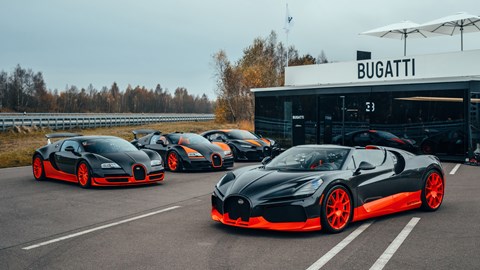
Andy Wallace, a Bugatti Pilote Officiel and Le Mans-winner was at the controls and first positioned the car on the banking at 124mph, before gradually increasing to the new record.
As you’d expect, the World Record Car, valued at €14million, is a little different to the standard version: it features ‘Jet Orange’ highlights inside and out, like Bugatti’s previous record cars.
‘The Bugatti World Record Cars throughout the marque’s history have represented the epitome of speed and power, setting new boundaries and redefining again and again, what Bugatti vehicles are capable of,’ said Bugatti CEO, Mate Rimac.
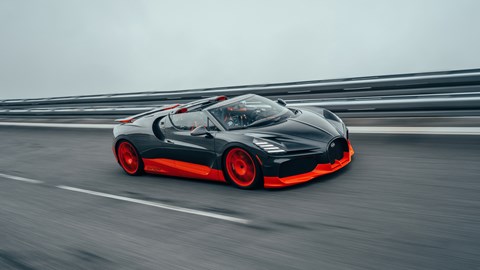
‘And now, with the unparalleled achievement of the W16 Mistral World Record Car etched into the history books, we see history not just repeating itself, but new history made.’
Keep reading for everything you need to know about the ‘standard’ car.
What you need to know
This is the Bugatti Mistral, a W16-powered roadster that is to the Chiron what the Veyron Grand Sport was to the regular Veyron.
It’s also an indication that Maserati’s copyright ran out on the Mistral name, allowing Bugatti to join a selection of VW Group cars named after winds such as the Golf, Jetta, Bora and Scirroco. Less flippantly, the name indicates the car’s ‘wind-in-your-hair’ design – while there will be a roof, it’s more intended for temporary or emergency use. First and foremost, this is an open-topped car.
Mistral is also a French wind, blowing from the Rhone River Valley through the Cote d’Azur and into the Mediterranean. And despite German ownership and a Croatian CEO, the brand’s very proud of its French heritage and would like to be seen as a French automobile brand.
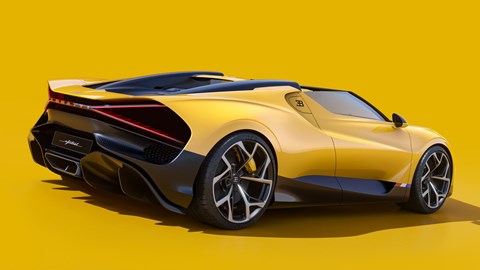
It’ll be shown off to the public during Monterey Car Week, at The Quail – but there’ll be no point rootling down the back of the sofa trying to stump up the Mistral’s 5 million Euro price tag, as all 99 examples have already been sold.
So it’s an open-topped Chiron?
Sort of. The Mistral shares a lot with the Chiron and looks quite similar, but Bugatti’s keen to point out that they haven’t just taken a hacksaw to the roof – it’s re-engineered and redesigned. Roadsters are rarely just an afterthought for the brand, and in fact 45% of all Bugatti vehicles ever created have been open-topped.
The front of the Mistral takes on a more vertical motif than the Chiron, with stacked headlights and a deeper, wider horseshoe grille more akin to exclusive models like the Divo or La Voiture Noire.
The windscreen and top line of the windows give a real wraparound ‘visor’ effect, hiding the A-pillars and providing a modern interpretation of the ‘Grand Raid’ Type 57, a 1934 roadster bodied by Gangloff. The Grand Raid also provides the colour scheme for the first Mistral, which is a warm black with yellow accents. That’s a personal homage to Ettore Bugatti, who chose yellow and black for many of his own cars.
Of course, customer cars will be painted in whatever hue is desired, with launch models rendered in Chiron blue, black and white.
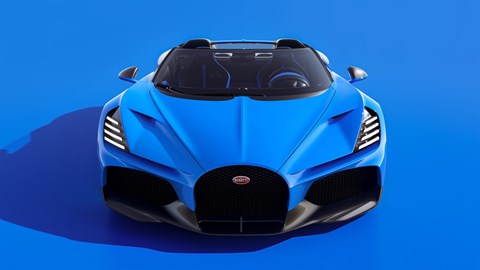
The airflow’s been very carefully split up with clever aero. The engine air intakes now sit on the roof, just behind the occupants’ heads – a further nod to the Veyron Grand Sport. They’re also strong enough to take on the duty of rollover hoops.
This leaves the air down the sides free for the oil coolers. The taillights take on an ‘X’ shaped motif, and the negative space between them is used to vent the side radiators.
Even the headlights have gaps between the LED bars, which funnel air out through the wheel arch to improve aerodynamic drag.
What’s under the bonnet?
You’ll find the Super Sport powertrain mounted just behind the driver – namely, Bugatti’s 8.0-litre W16 engine, here producing 1600 PS (1,578bhp). Bugatti’s targeting a 261mph top speed, which while not the fastest open-topped car ever does mean it’s no slouch.
It marks the last time this engine will be used in a road-going Bugatti – the end of an era that began with the Veyron in 2005. The design team kept very quiet about the future, saying only that it would be hybrid – but didn’t seem too sold on the idea. As design chief Achim Anscheidt admitted ‘I can stand here and give you all the design talk, but without the W16 engine this car has no selling point’.
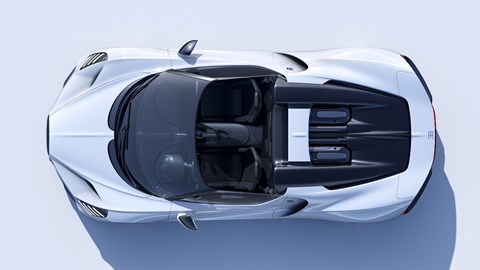
‘We know the W16 Mistral will always have significance in the story of Bugatti, marking the last time that perhaps the greatest ever automotive powertrain is used in the roadgoing production car.’
When further pressed, Bugatti execs stuck to the company line, saying only that the new hybrid powertrain would ‘pay respect to Bugatti’.
And what’s inside?
The interior’s very similar to the Chiron, with milled titanium and aluminium components set into a simple, curvaceous dash. What you won’t find is inch after inch of screen – Bugatti wants its cars to be collectors items that will function just as well many years later, something it doesn’t think can be done if the interior relies on delicate screens and fiddly software.
Anscheidt admits that most of Bugatti’s fabulously wealthy customers use their smartphones for navigation if they need to – just like the rest of us plebs – but that driving one of their cars is a consciously tech-free experience. They prefer exquisite materials and craftsmanship to the latest tech that’ll soon look dated. After all, very few Bugattis are daily drivers – a suction-cup phone mount would rather spoil the effect.
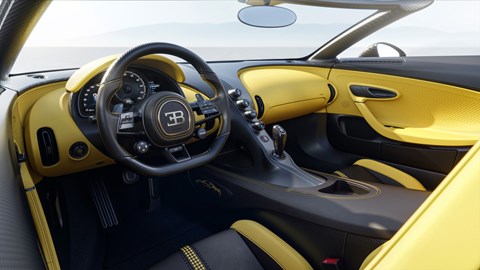
‘Will a screen still work as well in 15 or 30 years?’ he asks. ‘Even a Bugatti made today needs to be able to sit on the lawn at Pebble Beach in 30 years and still work.’
The colour scheme inside is once again inspired by warm black (with tones of brown) and yellow. A fabulous ‘woven’ leather appears on the seats and door cards. Handmade, of course – machine-cut experiments were too regular and boring.
Another nod to the past is in the gear selector, where a figure of a dancing elephant is encased in amber-like resin. It’s a homage to Rembrandt Bugatti’s famous sculpture, copies of which adorned the bonnet of the Type 41 Royale as Ettore’s tribute to his brother’s artwork.
Can I have one?
No. All 99 examples were sold before the public reveal (when we saw the car at a media reveal event a few weeks ago, Anscheidt was confident they would be) and even if you found yourself on that exclusive list, you’d have to shell out 5 million Euros for the privilege.
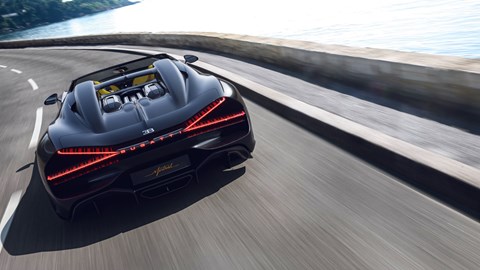
Most will have found themselves as exhibits in private collections – automotive art, designed to be admired first and driven second. A shame, given it’s the last outing for that glorious engine.
Mate Rimac, Bugatti Rimac CEO, said: ‘The union of a roadster format and our W16 powertrain is absolute perfection. With the roof removed, and a pair of large air intakes directly behind your head feeding around 70,000 liters of air through the engine every minute at full bore, driving the W16 Mistral connects you to the intricate workings of this revolutionary powertrain like no other Bugatti to date.’